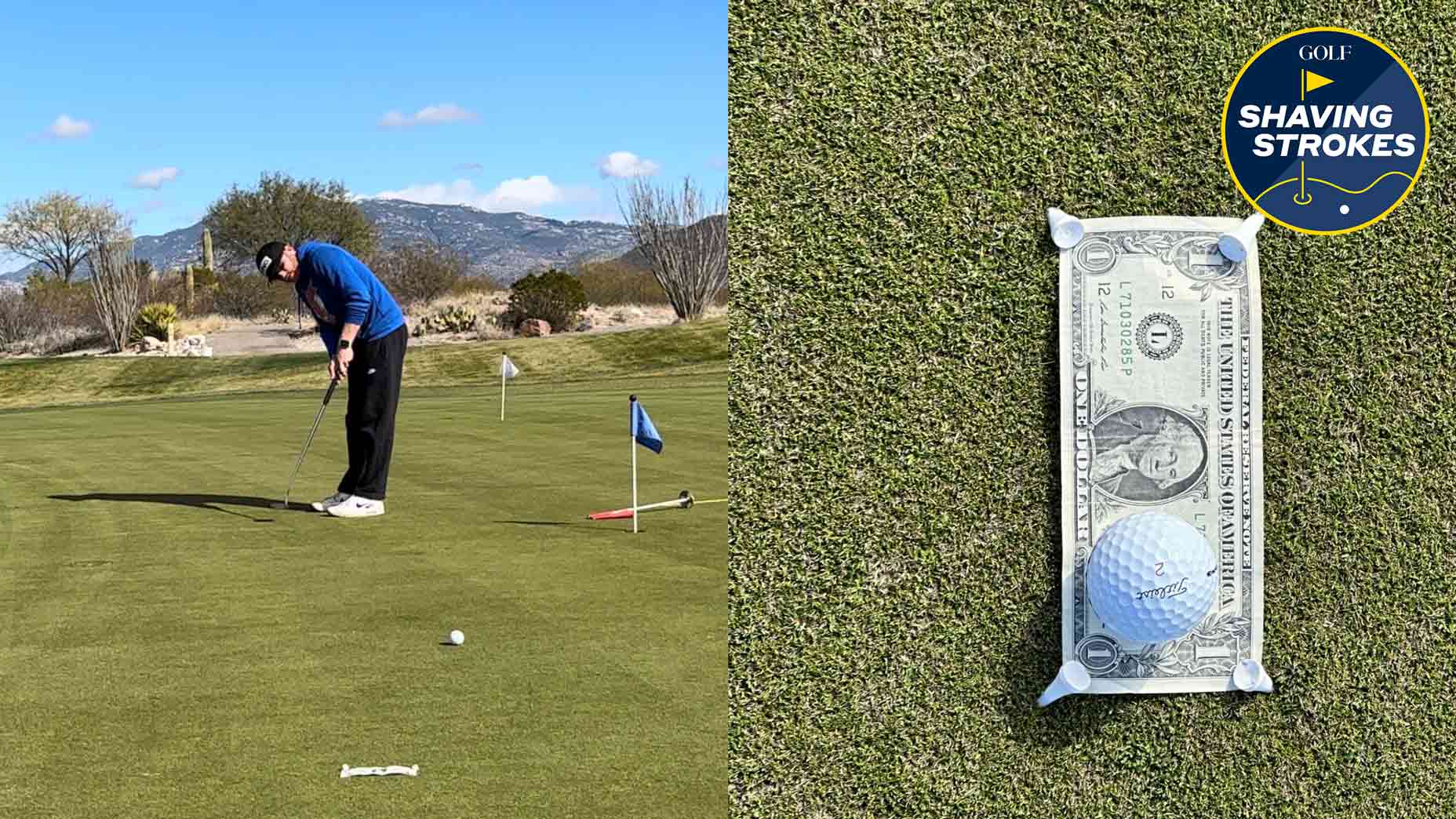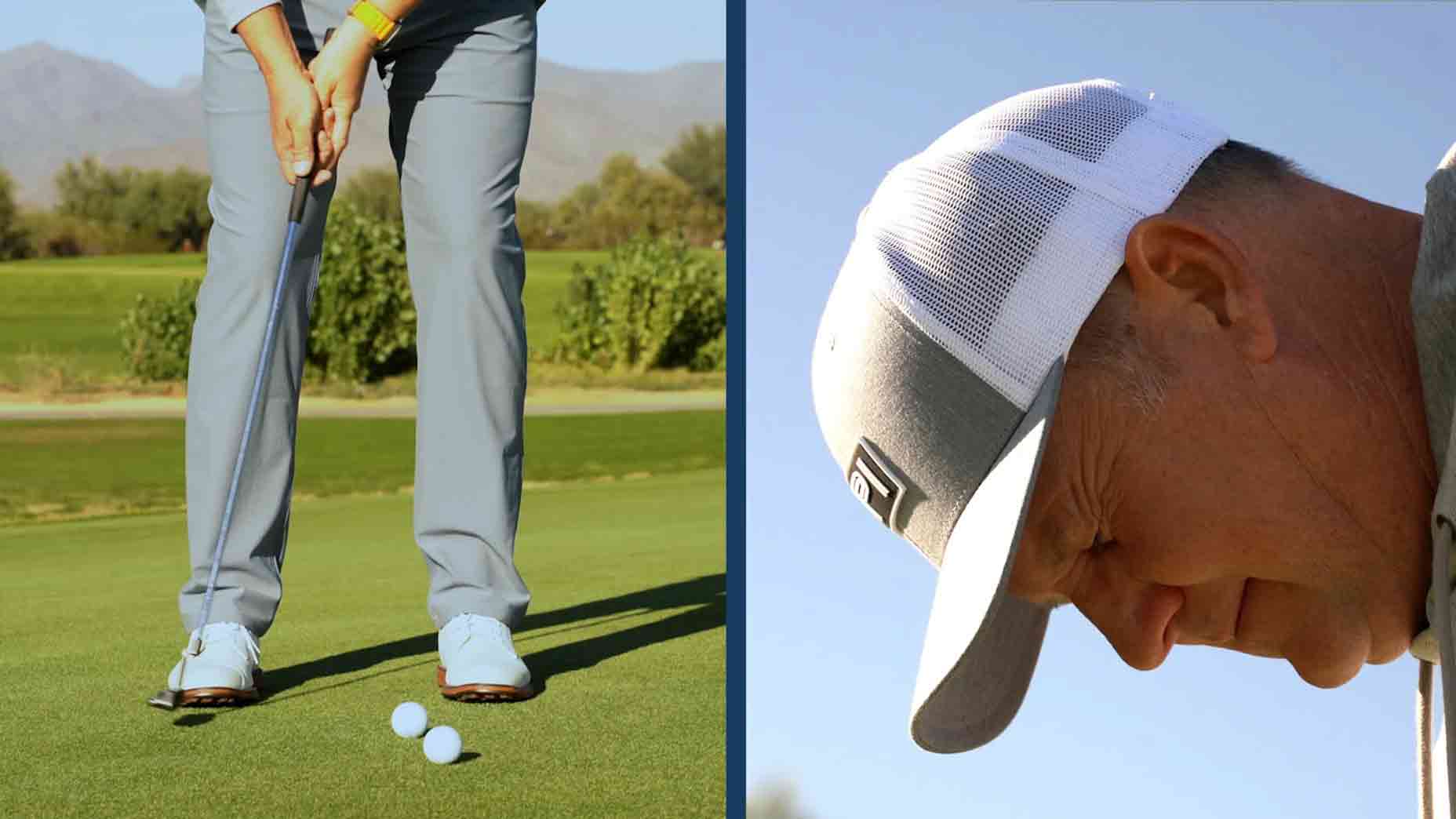
Putting guru Scott Curry shares his tips on a hot debate.
Image via Instagram/ScottCurryPutting
Welcome to Shaving Strokes, a GOLF.com series in which we’re sharing improvements, learnings and takeaways from amateur golfers just like you — including some of the speed bumps and challenges they faced along the way.
No matter what level of player you are, there’s a good chance you’ve got a routine that helps you lock in prior to hitting a shot. Whether that’s staring down and visualizing a result, or blocking out distractions and quietly giving yourself positive words of affirmation, most of us have a process — and it’s important to trust it.
One area of the game where focus is crucial is on the putting surface, as this is where you can instantly make up strokes.
But what’s the best pre-shot approach when holding the flat stick? Is taking a putting practice stroke necessary, or should you just confidently address your ball after visualizing the shot? It’s a debate that always seems to come up among players.
For instance, 2022 Open Champion Cameron Smith has been vocal about never taking a practice stroke with his putter, saying he relies on intuition to get a feel for how the ball will move — and sees the ball going in each time.
“I wouldn’t say I really work on my tempo so much,” Smith says. “I don’t take a practice stroke, so I like to kind of visualize and feel a lot, rather than feeling it through body motion. I guess I just like to visualize it.”
But you and I are not Cameron Smith, so what’s the best approach?
To help answer the question of practice stroke vs. no practice stroke, I checked in with short-game guru Scott Curry to get his thoughts. So check out Curry’s advice below, and try out some of his tips to see how you can improve on the putting surface.
Should you always take a putting practice stroke, or no?
Last year, as part of a study, neuroscientist Dr. Izzy Justice shared that 95 percent of the time, putting practice strokes have a negative impact on your putt, and that they don’t allow your focus to hold to your target. The study examined over 6,000 brain scans.
I’ve done over 6K brain scans on putting alone. Doing practice strokes just before hitting the putt has a negative impact on brain in over 95% of time. Eliminate your practice strokes to allow your brain to focus on holding your target.
— Dr. Izzy Justice (@izzyjustice) July 16, 2023
While I understand the data behind the study, I’d argue that the answer to the question of whether to take a practice stroke or not is, it depends.
Sure, that’s a bit of waffling, but hear me out.
As a putting instructor, as well as a former professional caddie, the vast majority of golfers take a practice stroke — but most of them are doing it with no intentionality, so it does more harm than good. I’ve seen routines with practice strokes result in both positive and negative outcomes.
Problem is, many amateurs lack a clear sense of why they’re taking a practice stroke to begin with.
Are they taking the practice stroke to gauge feel? If so, are they taking it right next to their ball and looking at a spot to help gauge slope, or are they simply looking at the hole?
When taking a practice stroke, players will sometimes become too fixated on trying to repeat that exact feeling during their actual shot. This often causes doubt, and having doubt causes more bad putting strokes than skill does. I’d much rather have a student be confidently wrong than doubt themselves.
I have students who take practice strokes and students that don’t, and there’s absolutely no difference in success.
The key is getting them to a point of confidence by trusting a routine that they can rely on under pressure, which would include knowing how to properly aim, having a system to control distance and creating a green-reading technique. Once they get to this point, it’s up to them whether they need to take an intentional practice stroke or not.
For instance, they’d no longer look at the hole during the practice stroke, they’d look at a target — which, depending on read and slope, could be two feet past the hole and three feet left of the hole. This is how to create a feel, allowing the tempo to remain consistent. If they simply look at the hole to create feel, they’re not taking the slope and read into account, and they subconsciously hit the ball harder or softer than they want to based off the slope.
This is why creating a process that you can trust is so important.
Here’s a good drill to try to determine whether you should use a practice stroke or not.
Place a tee 20 feet from your ball, take a couple practice strokes while looking at the tee to help create feel, then address the ball. Now close your eyes and try to mimic the exact same stroke you just made in your putting practice stroke. If the ball finishes close to the tee, you can have confidence that your feel matches your practice stroke. If the ball doesn’t finish near the tee, I’d try hitting the same putt without a practice stroke to see if that works better.
Here are a couple other pre-round tips to try from the practice green.
Don’t stress about making putts during practice, just learn the green
Put a tee in the ground on some slope, place your ball 10 feet away, read the putt, aim and hit your shot. If you do this twice and find that you’re missing either low or high, you can adjust and start over. By doing this, you’ll gain more confidence in your stroke as you make your way to the course. Remember that slope on each green appears differently due to color, grass type, etc., so use this to your advantage.
Focus on face angle at impact, not your putting stroke
Put a line on the ball and simply confirm that you’re rolling the ball consistently end-over-end. This will tell you that your stroke is neutral and that the face angle is good. This will also help eliminate doubt, which will allow you to focus more on rolling the ball instead of your actual putting stroke.
I personally don’t take a practice stroke, as I’ve created my own system to help control speed. So whether you decide to take one or not, I recommend finding the perfect (and consistent) pre-shot routine that allows you to be loose and free. Commit to it and believe in it!
Scott Curry is a putting coach and green reading specialist with over 20 years of experience. He’s helped players of all levels instantly improve by unlocking their potential on the green. You can learn more (and book a lesson) on his website.
Pelz Player Putting Mat
$109.99
INDOOR PUTTING MAT – Developed exclusively by Catalyst Golf in collaboration with Dave Pelz! The world renowned short game expert brings you a putting mat based on drills and games that Dave uses with top tour players to help win major championships
IMPROVE YOUR GOLF SCORE – Master putts inside 9 feet to help lower your score and become a better golfer. The same theory has been used with Master’s Champions Phil Mickelson and Patrick Reed
PUTTING GREEN – The Putting Mat comes with instructions, drills and tips to help you improve your aim, speed, and distance
MULTIPLE HOLE LENGTHS – Designed to work with the PELZ Player Putting Cups to help you setup your own indoor putting green studio. Putting Cups sold separately
INCLUDES – 1 putting mat 26″ x 126″ (10.5 feet) with rubber backing to ensure a smooth putting surface and 1 foam wedge used for ball return at end of mat and for creating breaks
View Product













